Remove the water pump pulley(A).
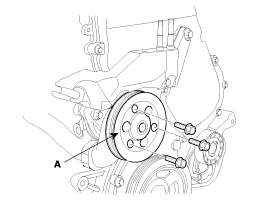
Drain the engine coolant.
System is under high pressure when the engine is hot.
To avoid danger of releasing scalding engine coolant, remove the cap only when the engine is cool.
Remove the drive belts.
Remove the water pump pulley(A).

Remove the water pump(A).
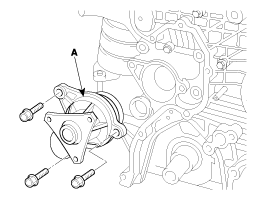
Disassembly of the thermostat would have an adverse effect, causing a lowering of cooling efficiency.
Drain the engine coolant so its level is below thermostat.
Remove the water inlet fitting(A), gasket and thermostat.
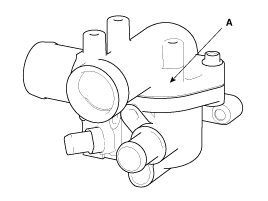
Drain the engine coolant. Remove the radiator cap to speed draining.
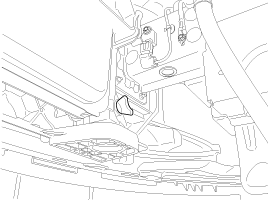
Disconnect the battery terminals(A).
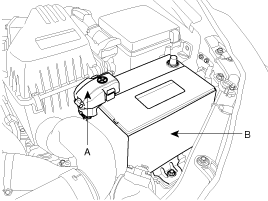
Remove the front cover(A).
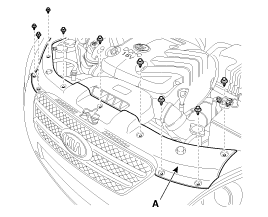
Remove the air duct(A).
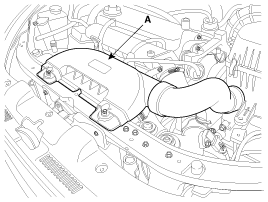
Remove the radiator upper hose(A).
Remove the radiator lower hose(B).
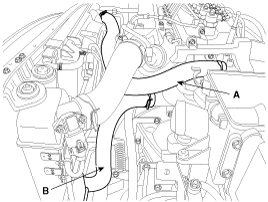
Remove the clamp on the cooling fan cover.
Disconnect the fan motor connector(A).
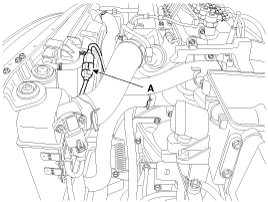
Disconnect the hose(A) between the reservoir and the radiator.
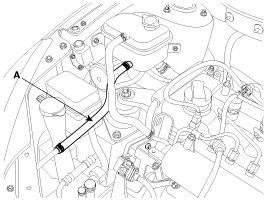
Remove the radiator upper mounting brackets.
Remove the blower assembly from the radiator.
Remove the condenser from the radiator.
Never remove the radiator cap when the engine is hot.
Serious scalding could be caused by hot fluid under high pressure escaping from the radiator.
When pouring engine coolant, be sure to shut the relay box lid and not to let coolant spill on the electrical parts of the paint. If any coolant spills, rinse it off immediately.
Slide the heater temperature control lever to maximum heat. Make sure the engine and radiator are cool to the touch.
Remove the radiator cap(A).
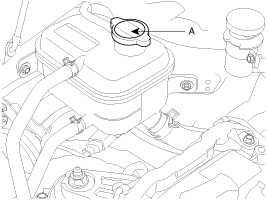
Loosen the drain plug(A), and drain the coolant.
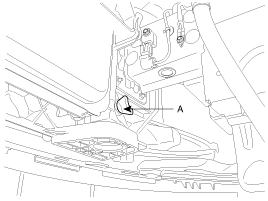
Tighten the radiator drain plug(A) securely.
Remove the coolant reservoir tank. Drain the coolant and reinstall the coolant reservoir tank. Fill the coolant reservoir tank to the MAX mark with the coolant.
Fill fluid mixture(coolant 5: water 5) with coolant and water slowly through the radiator cap. Gently squeeze the upper/ lower hoses of the radiator so as to bleed air easily.
Use only genuine antifreeze/coolant.
For best corrosion protection, the coolant concentration must be maintained year-round at 50% minimum. Coolant concentrations less than 50% may not provide sufficient protection against corrosion of freezing.
Coolant concentrations greater then 60% will impair cooling efficiency and are not recommended.
Do not mix different brands of antifreeze/coolants.
Do not use additional rust inhibitors or antirust products; they may not be compatible with the coolant.
Start the engine and allow coolant to circulate. When the cooling fan operates and coolant circulates, refill coolant through the radiator cap.
Repeat 7 until the cooling fan 3 ~ 5times and bleed air sufficiently out of the cooling system.
Fill the reservoir to the "MAX" line with coolant.
Stop the engine and allow coolant to be cool.
Repeat step 6 to 10 until the coolant level stays constant and all air is bleed out of the cooling system.
Recheck the coolant level in the reservoir tank for 2 ~ 3 days after replacing coolant.
Coolant capacity : 6.3 liters(6.66 US qt, 5.54 lmp qt)
Install the water pump(A) and a new O-ring.
Tightening torque :
19.6 ~ 24.5N.m (2.0 ~ 2.5kgf.m, 14.5 ~ 18.1lb-ft)

Install the water pump pulley(A).
Tightening torque :
9.8 ~ 11.8N.m (1.0 ~ 1.2kgf.m, 7.2 ~ 8.7lb-ft)

Install the drive belts.
Fill with engine coolant.
Start engine and check for leaks.
Recheck engine coolant level.
Place the thermostat in thermostat housing with new gasket.
Install the water inlet fitting(A).
Tightening torque :
19.6 ~ 24.5N.m (2.0 ~ 2.5kgf.m, 14.5 ~ 18.1lb-ft)

Fill with engine coolant.
Start engine and check for leaks.
Install the cooling fan to the radiator.
Tightening torque :
8.8 ~ 10.8Nm (0.9 ~ 1.1kgf.m, 6.5 ~ 8.0 lb-ft)
Install the radiator to the air conditioning condenser and the radiator upper bracket.
Connect the hose(A) between the radiator and the reservoir.

Connect the fan motor connector(A).

Install the upper(A) and the lower radiator hoses(B) and the automatic transaxle fluid(ATF) cooler hose.

Fill with engine coolant and install the air duct(A).

Start engine and check for leaks.
Check each part for cracks, damage or wear, and replace the coolant pump assembly if necessary.
Check the bearing for damage, abnormal noise and sluggish rotation, and replace the coolant pump assembly if necessary.

Check for coolant leakage. If coolant leaks from hole, the seal is defective. Replace the coolant pump assembly.
A small amount of "weeping" from the bleed hole is normal.
Immerse the thermostat in water and gradually heat the water.
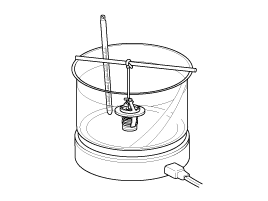
Check the valve opening temperature.
Valve opening temperature : 85±1.5°C (185±34.7°F)
Full opening temperature : 95°C (203°F)
If the valve opening temperature is not as specified, replace the thermostat.
Check the valve lift.
Valve lift : 8mm(0.3in) or more at 95°C (203°F)
If the valve lift is not as specified, replace the thermostat.
Remove the radiator cap, wet its seal with engine coolant, then install it no pressure tester.
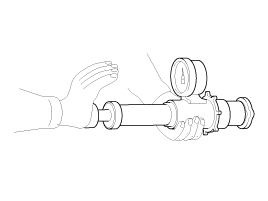
Apply a pressure of 93.16 ~ 122.58kpa (0.95 ~ 1.25kg/cm², 13.51 ~ 17.78psi).
Check for a drop in pressure.
If the pressure drops, replace the cap.
Wait until engine is cool, then carefully remove the radiator cap and fill the radiator with engine coolant, then install it on the pressure tester.
Apply a pressure tester to the radiator and apply a pressure of 93.16 ~ 122.58kpa (0.95 ~ 1.25kg/cm², 13.51 ~ 17.78psi).
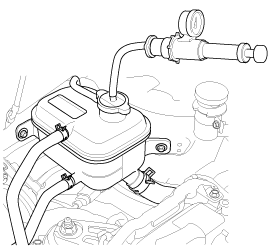
Inspect for engine coolant leaks and a drop in pressure.
Remove the tester and reinstall the radiator cap.
Check for engine oil in the coolant and/or coolant in the engine oil.